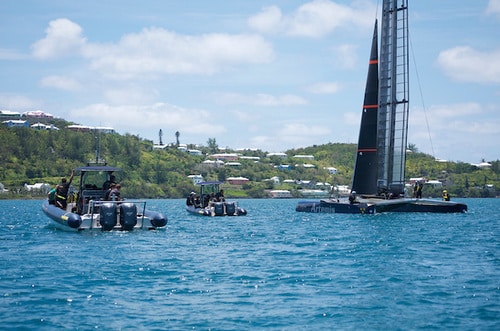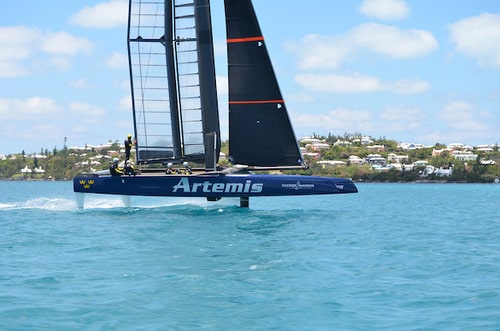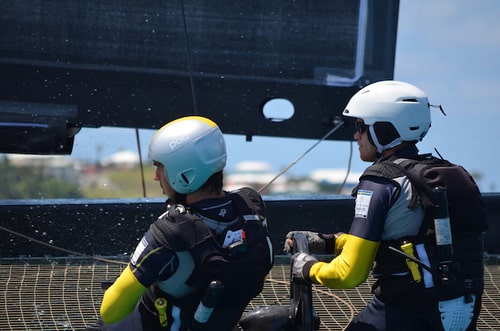America’s Cup sailing camps are in full swing in Bermuda, with Oracle Team USA and Artemis Racing out on the water most days of the week on their modified 45’s. Ben Ainsle Racing, the first to sail in Bermuda months ago, recently returned to Portsmouth, England to prepare for their role as host of the first America’s Cup World Series stop, and Softbank Team Japan is expected to arrive on the island next. Amid the hustle and bustle of mid-June on the island, we stopped by the Artemis Racing dorm to catch up with Design Coordinator Adam May to get the scoop on the latest developments.
Sailing World: So, this is a pretty cool place to sail…
Adam May: This is our second camp in Bermuda so far. We did a three-week camp in May, then a short camp now in June to check out the conditions at the venue around race-time. Something we’ve learned from the Olympics, which many of our team members have done, is that training at the venue is something that can’t be beat. You need to know what the challenges are, not just on the water, but in getting your base set up as well. We have a great, established base in San Francisco, and it was very tempting to do more time there, but then we wouldn’t get that time at the actual venue for the Cup. Bermuda has been so friendly and welcoming to us being here, so it’s been really good.
We plan on doing camps for now, with a bigger move to the new base at Morgan’s Point later on. These camps gave us the opportunity to decide when we’re going to do that big move—if we had arrived here and realized it was really difficult to do testing then we might’ve done something else, either stayed in San Francisco or sailed elsewhere to accomplish what we need to.
What have you learned from your camps at the venue so far?
Well, I could tell you but I’d have to kill you…We’ve really just been learning more about the race course. Initial impressions are that its very small, but actually having sailed here, it’s going to be a good size and produce good racing.
So far, we’ve had a few weeks of great breeze in June and July which we’re told is rather unusual. There has been stunning weather every day and a good range of conditions for practice and to get a good feel for the venue and the course.
When you’re here, you’ve been sailing on the modified AC45, or what you call the AC45 Turbo. Tell us a little more about the boat and it’s role in the development process.
The plan with the Turbo was to use it as a test-platform for the AC62. The protocol allowed you to modify one of your old AC45s, basically to retain the lower portion of the hull, and then anything else we could change. So, we took those hulls and we scaled the key variables that we were putting on the new 62 down for the 45. We wanted it to be as close to the 62 as possible. The beam became wider and more powerful, with more righting moment, so it’s faster. We changed the foil geometry positioning. We wanted to get the crew into cockpits like the 62 was going to be, which is a lot safer at the speeds we’re doing. The wing was extended a bit as well. These changes were to test as near to scale as possible to the 62. And, then the rule changed and we got even closer to the new design so it’s even more valuable as a training tool now.
So the rule change didn’t throw your development plans off too much?
One of the things to remember that even with the change was that we couldn’t backdate anything. We’d done a lot of work on the 62 already, and a lot of work on boats that we were already sailing. We couldn’t stop that; the 45s just became more relevant. And it wasn’t just us, every team was working on developments to their 45s and 62s in some capacity.
A lot of the development that we did on the 62s remained valid when the rule change was announced. Since we were already testing concepts on the modified AC45 at scale, they’re now closer in scale to what we’ll be racing in the AC Final in June 2017. The platform development was effectively traded away, as well as hull development. A bunch of those things will unfortunately sit there now, and not be seen, but I think the principle is that we’re thinking longer-term. Yes, there was a hit in this cycle, but the change needed to happen sooner rather than later because they really had to make a change at some point.
I think this is a positive change. Not that we particularly have a choice. The team that wins this Cup could very well be the team that deals with the changes best and just gets on with it. You can’t sit and complain about it. We already have a lot of experience sailing foiling 45s, and so the smaller boat is fine for us. We’ve got a very experienced team of small-boat sailors, so we’re quite happy as we’re used to that. But, the main thing is that the rule is what it is. If they said it was a 100-footer, we’d get on and deal with a 100-footer.
The only way to change the rules is to win it. That’s the bottom line.
Has the decrease in size in the boats been a challenge to manage when you already had a team mostly established?
The size of the boat has decreased, but the size of the sailing team hasn’t changed. We need spares and rotation, so the squad has mostly remained the same. The demands of the boat have change, though—how much reliance we need to have on the big, powerful guys who grind, versus the small boat guys who are more skilled foilers and lighter. That’ll be interesting to see how each team deals with that—do you change your personnel to fit the boat or stick with who you’d been planning for the 62? The decisions are still being made as we sail and learn more about these boats.
Let’s talk about the competition. Groupama Team France formalized their challenge pretty late in the competition. Did the rule change give them an advantage to come in without spending early time and money on a now non-raceable boat?
I’m not sure that it’s an advantage, because we’ve all been thinking about this for a long time. We’ve put so much time and energy into developing these boats and testing them. I don’t think they have an advantage coming in late, but the disadvantage is less considering the circumstances. There’s a much clearer landscape—we were all going off down one route with the 62s, and then there’s a change. They’re been able to hold off a bit on their 62 work and can work on the current class. If the rules hadn’t changed, I don’t think a team would have been able to come in at this point in the game. With the bigger boat, the longer build and development times, the differences would have been hard to overcome.
Softbank Team Japan came in after this change as well, and while it was unfortunate to lose Luna Rossa, there are a few other teams that are still talking about it and deciding if it’s too late or not. This leveling the playing field with the rule-change and the smaller boat is making it less daunting to come in late. The changes to the protocol really weren’t in relation to the 35th America’s Cup, but looking forward to the future and the next America’s Cup after that. As the size of the boats and the teams get smaller and more manageable, I think we’ll see the effects going into the next Cup far more so than this one.
You’ve been sailing against Oracle Team USA quite a bit in the Great Sound, how is that helping the progress?
We’ve agreed to a bit of race training with Oracle. We haven’t done any starts, we’ve more just lined up against each other. It’s powerful, the intensity increases. It’s always better to develop the boat when you’re against another. We can try new things and learn from them more easily than just doing it on our own.
The advantage is to both of us. We’re looking to step forwards as fast as we can and I think it can help us to do that.
It’s something different each day, but we learn in every area.
When you’re out practicing, you’ve got a swarm of chase boats following along. What exactly is happening aboard those ribs?
Well, that’d be a long and very complex answer. But, basically, the chase boats are observing, data logging for post-processing, and watching numbers to give direct feedback to the guys aboard. There’s a lot of data being processed and it takes a lot of time to put it all together. In the daily grind of sailing, you accumulate a lot of information.
The ribs are having a hard time keeping up with the foiling boat; it’s pretty full on. They have a much nicer ride on the 45 than we do in the rib. But, the fact that we’re in shorts and a t-shirt here in Bermuda is a nice change from full wet weather gear in San Francisco.
The World Series kicks off in Portsmouth, UK in just a few weeks. What were the major developments since the last go-around with the 45s racing in the series?
We’ve converted the AC45 “classics,” as we now call them, to foiling AC45s. It was a collaborative project, with a designer from every team coming together to design the new AC45s for the World Series. So, they’ve now got a full foiling configuration. All of the teams have to launch those in time for Portsmouth. We call it the AC45F.
On the other hand is our AC45 Turbo, which is not raced in the World Series. It’s consciously a development boat focused entirely on the final. We call ours the Turbo, Oracle calls theirs the Sport. There’s a bit of a battle of who’s is better. But, it’s basically an upgraded AC45 to give us a representative boat to train on and try design ideas on.
Between the World Series, developing the new race boat for the final, and then the qualifiers and playoffs, that seems like an awful lot of variables and logistics to manage. How does it all come together?
Logistics-wise, we’re split up into different groups. We have a group specifically dedicated to the World Series—that is entirely their project. It’s an entirely separate team, in addition to the core program which is all about the Cup. The World Series is great for the team as far as racing foiling boats, but it doesn’t offer much to the design team as far as development. We have to make it a balance of where to prioritize time, which is why we try to keep them separate.
With the small boat, everything now fits in a container, so we can decide to move things around and do some sailing in both San Francisco and Bermuda. It’s cheaper, easier, and faster.
The World Series is purely one design that tests sailing technique. That’s relatively easy for us to manage. Everything else is totally on our own schedule—you can do your own thing, race every day, not care about what the other teams or doing. Or, you can keep an eye on everyone else and do some upgrades, but when you’re doing the upgrades the boat is off the water. What you’ll see is the team doing upgrades on their test boats when the sailors are away competing in the World Series Events. It’s natural down time, so that’s when you catch up.












